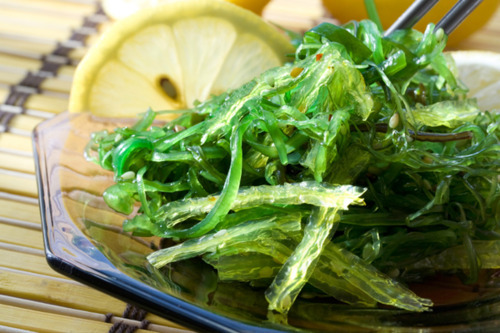Sea vegetables may be a better source of bioavailable iron than previously thought. One tablespoon of dried sea vegetable will contain between 1/2 milligram and 35 milligrams of iron, and this iron is also accompanied by a measurable amount vitamin C. Since vitamin C acts to increase the bioavailability of plant iron, this combination in sea vegetables may offer a special benefit.Brown algae (including the commonly eaten sea vegetables kombu/kelp, wakame, and arame may be unique among the sea vegetables in their iodine content. Some species from the brown algae genus Laminaria are able to accumulate iodine in up to 30,000 times more concentrated a form than sea water!Sea vegetables may be a unique food source not only of the mineral iodine, but also of the mineral vanadium.Sea vegetables may play a role in lowering risk of estrogen-related cancers, including breast cancer. Since cholesterol is required as a building block for production of estrogen, the cholesterol-lowering effects of sea vegetables may play a risk-reducing role in this regard. However, more interesting with respect to breast cancer risk is the apparent ability of sea vegetables to modify aspects of a woman’s normal menstrual cycle in such a way that over a lifetime, the total cumulative estrogen secretion that occurs during the follicular phase of the cycle gets decreased. For women who are at risk of estrogen-sensitive breast cancers, sea vegetables may bring a special benefit in this regard. Types of Sea VegetablesNot sure what sea vegetables to try? Here is a list describing their tastes and textures. Arame: Mild, semisweet flavor and thin but firm texture. Great as a side dish, but especially yummy with buckwheat. Hijiki: Robust in flavor and black in color. Hijiki is often tossed in salads. Kombu: Light in flavor and chewy. Expands and softens when soaked. Excellent food tenderizer and helps with the digestibility of beans. Adds a sweet flavor to root vegetables. Creates wonderful stocks and stews. Nori: Paper-thin, dark green sheets made from pressed sea vegetables. Nori has a flavor similar to tuna and was originally used as a sushi wrap. Nori flakes may be used as a flavorful condiment. Dulse: Savory-tasting, brownish green colored stalks. Wonderful for roasting with seeds and as a condiment. Wakame: Delicate, long, green strips. Wakame has a sweet flavor. When soaked, it expands a great deal, so cut it into small pieces. Wakame loves the company of carrots and parsnips and adds a sweet taste to legumes.Soaking Sea VegetablesSoaking sea vegetables will improve their digestibility, cooking time and taste. 1. Put sea vegetables in a bowl of cold water. Move your fingers through the stems. 2. Discard this water and rinse. Fill the bowl with cold water again and let sea vegetables stand for 15 to 20 minutes. Note: You can use the water to nourish your houseplants or rinse your hair. read more..

No comments:
Post a Comment